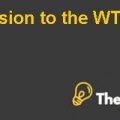Estimating Cisco’s Future Cash Flows Case Study Solution
The dividend payout ratio declined by 1% in the year 2016 as compared to the previous year, which indicates that less amount was paid to shareholders relative to the net income of the company. This might result in investor dissatisfaction and the sustainability of the business’s dividend payment stream.
The dividend yield of the business increased to 3.8% as compared to 2.8% in the previous year as a result of increasing dividends per share to $0.94 from $0.8 in 2015. Although a high dividend yield provides more income as compared to the share’s price, it also indicates that the share’s price is undervalued which is evident by the low P/E ratio.
Alternatives
The set of alternatives are recommended to Stark for makinga strategic decision on the basis of the current and past performance of the company. It would allow him to predict the performance of the company in the near future, more realistically. He could make use of the historical company’s data as it provides valuable insights on predicting the company’s future performance.
Alternative 1: Financial Ratio Analysis
Ratio analysis is a helpful tool in measuring the company’s profitability, evaluating operational efficiency, ensuring suitable liquidity, and reflecting the overall financial strength. The ratios can be compared with the prior year ratios in order to evaluate the progress of the company over the period of time.(Pooja Gupta, 2017).
The pros and cons of making the use of financial ratios to predict the future company’s performance, are discussed below:
Pros
- It helps in validating or disapproving the investment, financing and operating decisions of the company. The ratios help in evaluating and comparing the financial position of the company as well as the results of the management or investor’s decisions.
- It allows the investors to conduct a comparison with the industry trends, other firms and intra-firm comparison. This in turn provides valuable insights to understand the company’s financial standing in the economy.
- It helps in understanding the firm’ business risk through calculating the leverages, including: operating leverages and financial leverages. It provides an assistance in evaluating how profitable the company is with respect to its debt outstanding and fixed cost deployment.
- It provides valuable insight into the profitability, performance and overall earning power of the business.
- The trend can be conducted for future plans and forecasting, and helps investors in their decision making.
- It also simplifies the complex accounting standard and financial data into financial efficiency, operating efficiency, solvency and long term position.
Cons
- All the data used in conducting ratio analysis is derived from the actual results of historical data, which isn’t supposed to be carried forward into the future.
- The information on the income statement of the company is stated in the current cost; whereas the information on the balance sheet of the company is stated in the historical cost, which in turn might result in unusual results of the ratios.
- It illustrates the association between prior information and data while the investors seek about future and current data, which they are more concerned about.
Alternative 2: Discounted Cash Flow Analysis
The discounted cash flow analysis is another method used by investors to estimate the future return on the invested capital for the time value of money.(Schill, 2015).
The pros and cons of using suchmethod to predict the future profitability of the company, are discussed below:
Pros
- It is widely used to measure the investment’s attractiveness and relies on the company’s cash flow.
- The analysis also includes future expectations, also the internal rate of return is used to estimate the potential investment’s profitability.
- It can be used to assess the value and profitability of the company in the future.
- The terminal value helps in determining the company’s position.
- It includes the intrinsic value of the business and major assumptions related to the business.
- It also tells how much stocks of the company are undervalued or overvalued and whether the company’s price of the stock is justified or not.
- It allows the investors to embed the key changes in the company’s business strategy in the model of valuation, which otherwise would be unreflective in other models used for valuation, such as: APV etc.
Cons
- The DCF calculation requires a large number of assumptions and is sensitive to certain or little changes in assumptions.
- It is the ever-changing target that tends to demand constant modification and vigilance. In case of any change in the company; the fair value would be changed accordingly.
Alternative 3: Horizontal Analysis
The pros and cons of using suchmethod to predict the future profitability of the company, are discussed below:
Pros
- It allows the investors to assess the significant and relative changes in the items and project those items into the future.
- It helps in analyzing the situation of the trend.
- It helps in evaluating the long-term solvency position and short-term liquidity position of the company.
Cons
- It becomes useless at the time of the inflation or price level changes, hence providing misleading results.
- It does not follow the accounting convention and concepts vigilantly.
Recommendation:
After taking into consideration the key methods to predict the company’s profitability; various alternatives are discussed to ease Stark in determining the cash flows and trend of profit of the company by using the most effective as well as suitable tool.
Stark is advised to heavily rely on the ratio analysis to predict the future profitability of the company due to the fact that it would give a better picture of financing standing and position prior to years. It would assist in intend analysis, which involves a comparison of the company over time. Stark could make quick decisions on the basis of the decisive matrices usually followed by potential investors when he contemplatesinvesting in a certain organization (Cohen, 2000). Hence, the ratio analysis would help him in decision making by providing the financial position of the company. Also, he would be able to evaluate the efficiency of the company in terms of operations and management.
Conclusion:
Adam Stark has been contemplating to evaluate the strategy of the Cisco System Inc. by using the financials, which include the income statement of the company. By doing so, he would be able to better predict where the company would stand and what amount of cash flows it would generate in the forthcoming years. The ratio analysis is recommended over horizontal trend and discounted cash flow analysis because it helps in validating or disapproving the investment, financing and operating decisions of the company. The ratios help in evaluating and comparing the financial position of the company as well as the results of the management or investor’s decisions......................................
This is just a sample partical work. Please place the order on the website to get your own originally done case solution.












